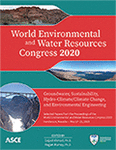World Environmental and Water Resources Congress 2020
Evaluation of Influences of ENSO Events on Changes in Temperature Extremes and Energy Consumption in South Florida
Publication: World Environmental and Water Resources Congress 2020: Groundwater, Sustainability, Hydro-Climate/Climate Change, and Environmental Engineering
ABSTRACT
El Niño southern oscillation (ENSO) events throughout the world are known to influence regional (or local) hydroclimatic variability and changes in essential climatic variables (i.e., temperature, precipitation, and others). Variations in temperature extremes influenced by ENSO may lead to spatial and temporal variability of energy consumption and better management strategies by energy utilities. The focus of this study is to assess the possible influences of El Niño southern oscillation (ENSO) events on regional temperature characteristics and extremes along with residential energy consumption in South Florida. The region of interest comprising three counties namely Miami-Dade, Broward, and Palm Beach. Evaluation of ENSO events on temperature is carried out using long-term monthly mean, minimum, and maximum temperature data from 1961–2018 from serval sites located in these counties. Joint variation of monthly electricity consumption obtained from a local power utility and temperature data available from the year 2001 to 2018 are used in the study. Temporal windows that coincide with three phases of ENSO (i.e., warm, cool, and neutral) are used to evaluate changes in temperature and energy consumptions. Nonparametric hypothesis tests are used to confirm statistically significant changes in temperature and energy in different phases of ENSO. This study is expected to provide insights into the possible spatial and temporal influences of ENSO events on temperature and residential electricity consumption for South Florida. Preliminary results suggest that spatially non-uniform variations in temperature influenced by El Niño and La Niña events affect the residential energy consumption in South Florida. Insights gained from this study can help local power utilities to plan and manage energy production and distribution for future ENSO events.
Get full access to this article
View all available purchase options and get full access to this chapter.
REFERENCES
1.
Beller-Simms, N., Planning for El Niño: The Stages of Natural Hazard Mitigation and Preparation. The Professional Geographer, Vol. 56, pp: 213-222, 2004
2.
Chen, H. and Teegavarapu, R., Relationship between Ocean-Atmospheric Variability and Regional Baseflow of the Continental United States, World Environmental and Water Resources Congress, May 2019. [available at: https://ascelibrary.org/doi/10.1061/9780784482346.030 ]
3.
California’s Fourth Climate Change Assessment Report – Climate Adaptive Response Estimation: Short and Long Run Impacts of Climate Change on Residential Electricity and Natural Gas Consumption, University of California, Berkeley & California Energy Commission, 2018
4.
EIA : Strong El Niño helps reduce U.S. winter heating demand and fuel prices, U.S. Energy Information Administration and National Oceanic and Atmospheric Administration, April 25, 2016
5.
Glantz, Michael H., Currents of Change – Impacts of El Niño and La Niña on Climate and Society. Cambridge University Press, 2001
6.
Goly, Aneesh: Influences of climate variability and change on precipitation characteristics and extremes. Ph.D. Thesis, Florida Atlantic University, 2013
7.
Hagemeyer, B. C., Extreme Rainfall and Temperature Anomalies in Florida dry season. NOAA 32nd Annual Climate Diagnostics and Prediction Workshop. Tallahassee, FL (2010). [available at: https://www.weather.gov/mlb/enso_florida_temperature ]
8.
Hernandez, G., The Economic Implications of an El Niño, National Oceanic and Atmospheric Administration, 2002. [available at: http://www.spacedaily.com/news/pacific-02g.html ]
9.
Lee, M. Y., Mandatory or Voluntary Water Conservation: A Case Study of Iowa Communities During Drought, Journal of Soil & Water Conservation, Vol 36, pp: 231-234, 1981.
10.
McPhaden, Michael J., Genesis and Evolution of the 1997-1998 El Niño. Journal of Science, Vol 283, pp: 950-953, 1999.
11.
Ropelewski, C. F. & Halpert, M. S. North American precipitation and temperature associated with the E1 Nifio Southern Oscillation (ENSO). Monthly Weather Review, Vol. 11, pp: 2352–2362, 1986.
12.
South Florida Climatological Report, National Weather Service, [available at: https://www.weather.gov/mfl/summer_season]
13.
Williams, Jack, How the super El Niño of 1982-83 kept itself a secret, The Washington Post, June 12, 2015 [available at: https://www.washingtonpost.com/news/capital-weather-gang/wp/2015/06/12/how-the-super-el-nino-of-1982-83-kept-itself-a-secret/ ]
Information & Authors
Information
Published In
World Environmental and Water Resources Congress 2020: Groundwater, Sustainability, Hydro-Climate/Climate Change, and Environmental Engineering
Pages: 290 - 301
Editors: Sajjad Ahmad, Ph.D., and Regan Murray, Ph.D.
ISBN (Online): 978-0-7844-8296-4
Copyright
© 2020 American Society of Civil Engineers.
History
Published online: May 14, 2020
Published in print: May 14, 2020
Authors
Metrics & Citations
Metrics
Citations
Download citation
If you have the appropriate software installed, you can download article citation data to the citation manager of your choice. Simply select your manager software from the list below and click Download.
